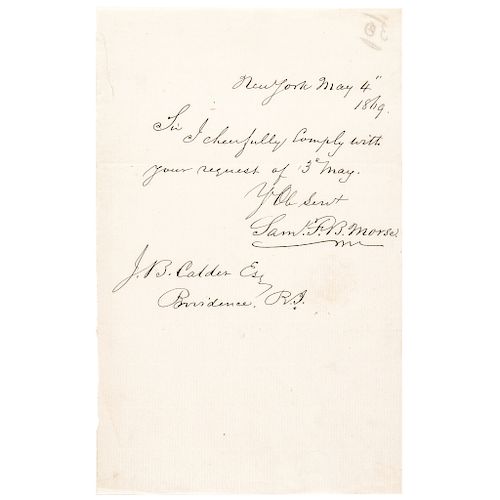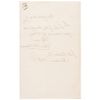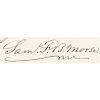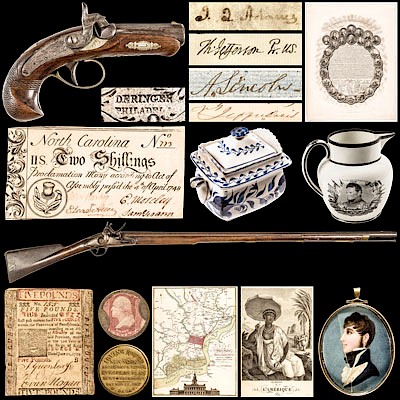SAMUEL F. B. MORSE 1869 Lovely High Quality Short Autograph Letter Signed
Lot 70
Categories
Estimate:
$1,400 - $1,800
Absentee vs Live bid
Two ways to bid:
- Leave a max absentee bid and the platform will bid on your behalf up to your maximum bid during the live auction.
- Bid live during the auction and your bids will be submitted real-time to the auctioneer.
Bid Increments
| Price | Bid Increment |
|---|---|
| $0 | $10 |
| $200 | $20 |
| $300 | $25 |
| $500 | $50 |
| $1,000 | $100 |
| $2,000 | $200 |
| $3,000 | $250 |
| $5,000 | $500 |
| $10,000 | $1,000 |
| $20,000 | $2,000 |
| $30,000 | $2,500 |
| $50,000 | $5,000 |
| $100,000 | $10,000 |
| $200,000 | $20,000 |
| $300,000 | $25,000 |
| $500,000 | $50,000 |
About Auction
By Early American History Auctions
Oct 19, 2019
Set Reminder
2019-10-19 12:00:00
2019-10-19 12:00:00
America/New_York
Bidsquare
Bidsquare : Historic Autographs-Currency-Political-Americana-Militaria-Guns
https://www.bidsquare.com/auctions/early-american-history-auctions/historic-autographs-currency-political-americana-militaria-guns-4513
326 Lots of Rare, Historic Autographs, Americana, Civil War Era, George Washington, Abraham Lincoln, Black History, Revolutionary War Era, Colonial America, Federal Period, War of 1812, Colonial Currency, Indian Peace Medals & more... Early American History Auctions auctions@earlyamerican.com
326 Lots of Rare, Historic Autographs, Americana, Civil War Era, George Washington, Abraham Lincoln, Black History, Revolutionary War Era, Colonial America, Federal Period, War of 1812, Colonial Currency, Indian Peace Medals & more... Early American History Auctions auctions@earlyamerican.com
- Lot Description
Autographs
1869 "Sam. F.B. Morse." Lovely Autograph Letter Signed
SAMUEL F. B. MORSE (1791-1872). American Portrait Painter, Pioneer of Photography and Inventor of a single-wire Telegraph System and his "Morse Code."
May 4, 1869-Dated, Autograph Letter Signed, "Sam. F.B. Morse.", 5" x 8.25", 1 page, New York, Choice Extremely Fine. Crisply penned short cordial Letter to J. B. Calder in Providence, Rhode Island. It reads, in full: "I cheerfully comply with your request of 3 May." Typical transmittal folds, bright, fresh clean and well written with a wonderful signature, being excellent in its eye appeal for display.
In 1825 New York City had commissioned Morse to paint a portrait of Lafayette in Washington, DC. While Morse was painting, a horse messenger delivered a letter from his father that read, "Your dear wife is convalescent". The next day he received a letter from his father detailing his wife's sudden death.
Morse immediately left Washington for his home at New Haven, leaving the portrait of Lafayette unfinished. By the time he arrived, his wife had already been buried. Heartbroken that for days he was unaware of his wife's failing health and her death, he decided to explore a means of rapid long distance communication.
While returning by ship from Europe in 1832, Morse encountered Charles Thomas Jackson of Boston, a man who was well schooled in electromagnetism. Witnessing various experiments with Jackson's electromagnet, Morse developed the concept of a single-wire telegraph. He set aside his painting, The Gallery of the Louvre. The original Morse telegraph, submitted with his patent application, is part of the collections of the National Museum of American History at the Smithsonian Institution. In time the Morse code, which he developed, would become the primary language of telegraphy in the world. It is still the standard for rhythmic transmission of data.
Meanwhile, William Cooke and Professor Charles Wheatstone had learned of the Wilhelm Weber and Carl Gauss electromagnetic telegraph in 1833. They had reached the stage of launching a commercial telegraph prior to Morse, despite starting later. In England, Cooke became fascinated by electrical telegraphy in 1836, four years after Morse. Aided by his greater financial resources, Cooke abandoned his primary subject of anatomy and built a small electrical telegraph within three weeks. Wheatstone also was experimenting with telegraphy and (most importantly) understood that a single large battery would not carry a telegraphic signal over long distances.
He theorized that numerous small batteries were far more successful and efficient in this task. (Wheatstone was building on the primary research of Joseph Henry, an American physicist.) Cooke and Wheatstone formed a partnership and patented the electrical telegraph in May 1837, and within a short time had provided the Great Western Railway with a 13-mile (21 km) stretch of telegraph. However, within a few years, Cooke and Wheatstone's multiple-wire signaling method would be overtaken by Morse's cheaper method.
In an 1848 letter to a friend, Morse describes how vigorously he fought to be called the sole inventor of the electromagnetic telegraph despite the previous inventions.
I have been so constantly under the necessity of watching the movements of the most unprincipled set of pirates I have ever known, that all my time has been occupied in defense, in putting evidence into something like legal shape that I am the inventor of the Electro-Magnetic Telegraph! Would you have believed it ten years ago that a question could be raised on that subject?
- S. Morse
- Shipping Info
-
Early American provides in-house worldwide shipping. Please contact us directly if you have questions about your specific shipping requirements.
-
- Buyer's Premium



 EUR
EUR CAD
CAD AUD
AUD GBP
GBP MXN
MXN HKD
HKD CNY
CNY MYR
MYR SEK
SEK SGD
SGD CHF
CHF THB
THB










![1667 Land Deed [Massachusetts Bay Colony / Boston] on Parchment](https://s1.img.bidsquare.com/item/m/2949/29492002.jpeg?t=1TIB0e)


